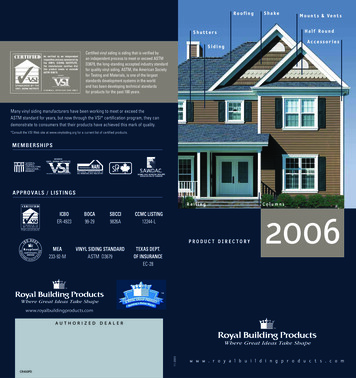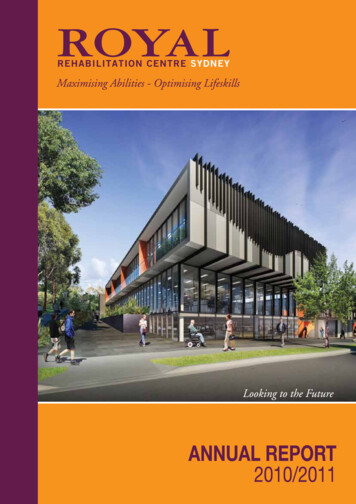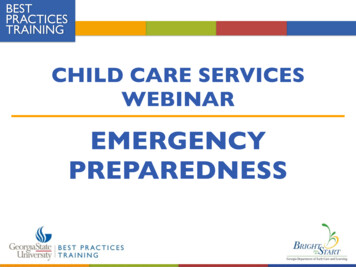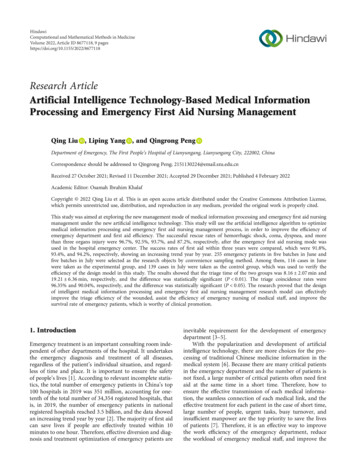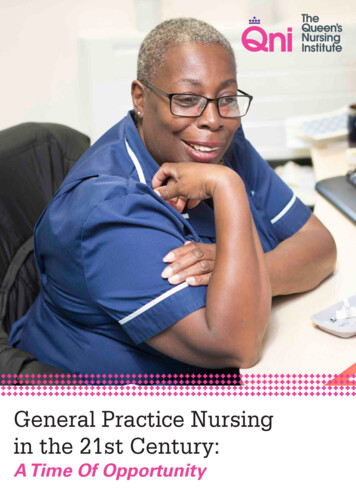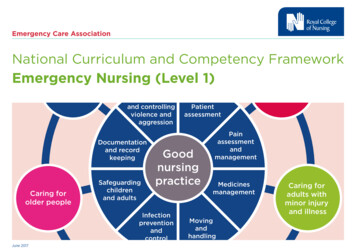
Transcription
Caring foracutelyill adultsEmergency Care AssociationNational Curriculum and Competency FrameworkEmergencyCaring forEmergencyplanning andNursing (Level 1)adults requiringdisastermanagementPreventingand controllingviolence andaggressionDocumentationand recordkeepingCaring forolder peopleSafeguardingchildrenand npreventionandcontrolJune nesmanagementMovingandhandlingCaring foradults withminor injuryand illness
Contents Introduction Level 1 competenciesAcknowledgementsThis Royal College of Nursing (RCN) curriculum and competency framework for emergencynursing was produced by a working party of emergency nursing representatives from acrossthe United Kingdom. Special thanks go to the individuals who gave their time and expertise tomake this possible.Working party membersJanet Youd Chair, RCN Emergency Care Association (ECA), Emergency Nurse Consultant,Calderdale and Huddersfield NHS Foundation TrustBruce Armstrong OBE Consultant Nurse in Emergency Care, Hampshire Hospitals NHS Foundation Trust,Hampshire and Isle of Wight Air AmbulanceJasmin ClarkAdvanced Nurse Practitioner, Royal Infirmary EdinburghAnna Crossley Royal College of Nursing (RCN) Professional Lead for Acute, Emergency and CriticalCareRoisin Devlin ECA Committee Member, Lead Nurse for Emergency Departments, South EasternHealth and Social Care Trust, Northern IrelandOwen Hammett ECA Committee Member, Trainee Specialist Practitioner – Critical Care, SouthWestern Ambulance Service NHS Foundation TrustJacky PriceECA Committee Member, Principal Lecturer University of HertfordshireKevin Randall Lead Nurse/ANP Emergency Department, Bridgend, Abertawe Bro MorgannwgUniversity Health BoardMichelle RuddEmergency Nurse Consultant, Lincolnshire HospitalsRCN Legal DisclaimerMandy Rumley-Bus ECA Committee Member, Consultant Nurse, Emergency Care ImprovementProgrammeThis publication contains information, advice and guidance to help members of the RCN. It is intended for usewithin the UK but readers are advised that practices may vary in each country and outside the UK.Simon Standen ANP/Matron, University Hospitals Leicester/Paramedic Consultant, YorkshireAmbulance ServiceThe information in this booklet has been compiled from professional sources, but its accuracy is notguaranteed. Whilst every effort has been made to ensure the RCN provides accurate and expert informationand guidance, it is impossible to predict all the circumstances in which it may be used. Accordingly, the RCNshall not be liable to any person or entity with respect to any loss or damage caused or alleged to be causeddirectly or indirectly by what is contained in or left out of this website information and guidance.Dr Anne Welling Emergency Nurse Consultant, Portsmouth, Chair Wessex Emergency CareCollaborationJill Windle RCN Fellow, Lecturer Practitioner, Salford University/Salford Royal NHSFoundation TrustIn addition to individual work, the development of this framework would not have been possible without thepreceding work shared or published by various organisations; in particular the Wessex Emergency CareCollaboration, the Faculty of Emergency Nursing and the Intercollegiate Board for Training in Pre-HospitalEmergency Medicine (IBTPHEM).2Published by the Royal College of Nursing, 20 Cavendish Square, London W1G 0RN 2017 Royal College of Nursing. All rights reserved. No part of this publication may be reproduced, stored ina retrieval system, or transmitted in any form or by any means electronic, mechanical, photocopying,recording or otherwise, without prior permission of the Publishers. This publication may not be lent, resold,hired out or otherwise disposed of by ways of trade in any form of binding or cover other than that in which itis published, without the prior consent of the Publishers.COMPETENCIES: NATIONAL CURRICULUM AND COMPETENCY FRAMEWORK FOR EMERGENCY NURSING (LEVEL 1)ACKNOWLEDGEMENTS
Contents Introduction Level 1 competenciesForewordOver 20 million patients access emergency and urgent care in the NHS each year in a range ofsettings and services. Central to each of these services are the nursing teams working alongsideother professional colleagues to ensure that these patients and their families receive world-classcare. The increasing demands and challenges on the NHS emergency care system have seen itevolve significantly in the last twenty years in the United Kingdom. Technological and clinicaladvances, coupled with the introduction of integrated emergency care networks, involving majortrauma centres, and other centres of excellence, with emergency departments and urgent carecentres, ensure patients can expect to receive quality and compassionate care responsive totheir needs.Alongside these clinical and service developments, emergency nursing has also progressed, bothin terms of its ability to improve outcomes for patients and their families, and to enrich theprofession of nursing itself, through evidence-base and role development. There is now anincreasing diversity of nursing roles required in emergency care settings, demanding specialistand advanced skills and knowledge. Each brings a significant contribution to the multiprofessional team in the modern emergency care environment.This framework, developed by leading emergency nursing experts, is founded on nursingphilosophy and details the depth and breadth of knowledge and skills required of emergencynurses. It offers long overdue clarity on the nomenclature of nursing roles in emergency caresettings and provides a clear career structure for those wishing to advance in the specialism. Itwill facilitate consistency and continuity of educational preparation of emergency nursing teams,as well as future workforce planning, and will be an extremely valuable resource for bothindividual nurses and organisations.Ruth MayExecutive Director of NursingNHS Improvement3COMPETENCIES: NATIONAL CURRICULUM AND COMPETENCY FRAMEWORK FOR EMERGENCY NURSING (LEVEL 1)FOREWORD
Contents Introduction Level 1 competenciesContents1Introduction5Preceptorship and induction5Glossary of nursing roles6Emergency nurse development pathway7Foundation practice – Working to Level 1 competencies8Emergency nurses – Working to Level 2 competencies8Emergency nurse development – Beyond Level 28The competence framework9Good nursing practice10Cross-cutting themes11Emergency care clinical domains12Cross-cutting themes Level 124CCT1 – Patient assessment25CCT2 – Pain assessment and management27CCT3 – Medicines management28CCT4 – Moving and handling30CCT5 – Infection prevention and control31CCT6 – Safeguarding children and adults32CCT7 – Documentation and record keeping34CCT8 – Preventing and controlling violence and aggression35Clinical domains Level 136CD1 – Caring for acutely ill adults36Competence assessment13CD2 – Caring for adults requiring resuscitation52CD3 – Caring for adults with minor illness or injury62The role of the clinical supervisor/assessor/mentor14CD4 – Caring for children and young people70CD5 – Caring for people with mental health needs8215CD6 – Caring for older people87GNP1 – Professional behaviour16CD7 – Emergency planning and disaster management93GNP2 – Team working17GNP3 – Communication18GNP4 – Leadership and management19GNP5 – Education20GNP6 – Evidence-based practice21GNP7 – Legal and ethical dilemmas and decision making22GNP8 – Service evaluation and improvement232Level 1 competencies:Good nursing practice Level 14COMPETENCIES: NATIONAL CURRICULUM AND COMPETENCY FRAMEWORK FOR EMERGENCY NURSING (LEVEL 1)CONTENTS
Contents Introduction Level 1 competencies1. IntroductionThis framework was produced in response to a demand from RCN Emergency Care Associationmembers for clarity in the competencies expected of nurses working in emergency care settingsacross the UK. Whilst its development focused on the needs of nurses working in emergencydepartments (EDs), the framework will also be applicable to nurses working in a wide range ofurgent and emergency care settings and also other health care professionals who are required tocare for patients in emergency care settings. The aim is to encourage professional development,leadership skills, and career progression in emergency nursing; promoting high quality patientcare and a culture that supports recruitment and retention of emergency nurses. The frameworkis designed to support nurses from newly qualified or new to the specialty (foundation staffnurse) through to more experienced emergency nurses working with patients of all ages.Nurses working in emergency care settings that receive trauma should also follow the traumacompetency framework developed by the National Major Trauma Nursing Group. Thesecompetencies can be found at: www.nmtng.co.uk/emergency-dept-1.htmlCompetencies for advanced clinical practitioners in emergency care have been developed by theRoyal College of Emergency Medicine (RCEM) and Health Education England (HEE). These havebeen endorsed by the RCN and are available at: www.rcem.ac.uk/RCEM/Exams Training/Emergency Care ACP/RCEM/Exams Training/Emergency Care ACP/Emergency Care ACP.aspx?hkey ll nurses joining the NMC register have demonstrated their ability to undertake a wide range ofcore nursing skills with competence. This framework recognises the acquisition of these skills andseeks to build specific competence in emergency nursing. The guidance provided in thePreceptorship framework for newly registered nurses, midwives and allied health professions (DH,2009), should act as a useful resource.InductionA period of structured support is vital for all nurses who are new to the emergency careenvironment. For nurses who have clinical experience elsewhere, their transition into emergencycare may be less challenging, and their progress in achieving the competencies may beaccelerated in comparison to that of the newly qualified nurse.The emergency care environment is stressful and challenging and for emergency nurses todevelop and work effectively, they need to maintain personal wellbeing. To develop resilience,emergency nurses should feel supported in exploring their experiences, to enable reflection andlearning. The need for emotional support at any stage in an emergency nurse’s career shouldnever be underestimated.ReferencesDepartment of Health (2009) Preceptorship framework for newly registered nurses, midwives andallied health professions. London: DH.5COMPETENCIES: NATIONAL CURRICULUM AND COMPETENCY FRAMEWORK FOR EMERGENCY NURSING (LEVEL 1)INTRODUCTION
Contents Introduction Level 1 competenciesGlossary of nursing roles in the emergencycare settingFoundation staff nurse: A registered nurse who is either newly qualified or new to emergencynursing; has not yet acquired the competencies of an emergency nurse. These nurses requiresupervision in practice, ranging from direct supervision in their initial weeks, to indirectsupervision as they near the accomplishment of an emergency nurse. They should be working tocomplete the Level 1 competencies. Typically, they would be Band 5.Emergency nurse: A registered nurse who has completed preceptorship and has achievedthe Level 1 competencies. They can work with individual patients or groups of patients withoutdirect supervision in the emergency care setting. This includes initial assessment and theprovision of treatment (but not diagnosis) for patients. In EDs, this is likely to include working withpatients in the resuscitation room, those with major illness or injury and those with minorpresentations. They should be working to complete the Level 2 competencies. Typically, theywould be Band 5 or 6.Emergency charge nurse: An emergency nurse who has completed level 2 competencies, is aclinical expert and proactively develops themselves and others. They lead and supervise theclinical work of others and can manage the emergency care setting as a whole; managing patientflow and delegating care accordingly. In EDs they should work in close partnership with theemergency medicine consultant to ensure safety of patients and best use of resources. Theyshould focus on more in-depth leadership, educational and/or research competencies, which arebeyond the scope of this framework. Typically, they would be senior Band 6 or 7.Emergency nurse practitioner (ENP): A registered nurse who has undertaken specificadditional training in order to assess, diagnose and prescribe treatment for patients who presentwith minor injuries and or illness. The role of emergency nurse practitioner is subject to localvariation in education and practice provision, therefore this framework does not provide thecompetencies required for this role. Typically, they would be Band 6 or 7.Practice educator: This is an emergency nurse having completed Level 2 competencies whofacilitates educational opportunities in the emergency care setting. They provide supervision inpractice, deliver training sessions and assessment of competencies. They often teach on nationallyrecognised courses (for example, advanced life support). They should be working towardseducation-specific competencies and/or qualifications. Typically, they are Band 6 or 7 dependingon the leadership responsibilities of the role.Practice development lead: This is an emergency nurse having completed Level 2competencies who leads the education strategy for the emergency care setting. They will providesupervision in practice and deliver some training sessions, whilst establishing the trainingrequirements in the setting to ensure the necessary workforce skill mix. They will link theeducation strategy for the emergency care setting with the overall strategy for education in theorganisation. They will work closely with the lead nurse manager, the medical clinical director andother education providers, including higher education institutes (HEIs). They will typically be Band7 or 8a.Lead nurse manager: This is an emergency nurse having completed Level 2 competencies whois responsible for the day-to-day operational management of the emergency care setting,including workforce management and implementation of local policy and clinical guidelines.Typically, Band 7 or 8a.Matron: This is an emergency nurse having completed Level 2 competencies who is responsiblefor quality assurance and quality improvement in the emergency care setting; includingresponding to patient feedback and ensuring clinical incidents are investigated and anyrecommendations actioned. Typically, Band 8a.Emergency nurse consultant: A clinical expert in emergency nursing with responsibility foremergency care leadership; including strategic development of policy and practice, research,education and advanced clinical practice. Typically, Band 8b or 8c.Advanced clinical practitioner (ACP): An emergency nurse or other registered allied healthprofessional who has undergone masters level education in examination, diagnosis and treatmentand can provide a clinical consultation for any patient presenting to emergency care. They shouldbe working to the Royal College of Emergency Medicine/Health Education England emergencycare ACP competency standards. Typically, they would be Band 8a or 8b.6COMPETENCIES: NATIONAL CURRICULUM AND COMPETENCY FRAMEWORK FOR EMERGENCY NURSING (LEVEL 1)INTRODUCTION
Contents Introduction Level 1 competenciesEmergency nurse development pathwayA clearly defined development pathway enables nurses to identify their position on a careerjourney, consider future options and plan the steps required to achieve their career aims.Figure 1 maps the professional development pathways into management, education or clinicalspecialist roles for emergency nurses. Defining stages within the pathway not only facilitatescareer progression, but may also inform workforce development.Figure 1: Career development pathway overviewCareer development pathway overviewAdvancing clinical practice pathwayNewly qualified nurseENPBand 6(Foundation staffnurse Band 5)Working to Level 1(Working to Level 2)PracticeeducatorBand 6New to specialty nurse(Foundation staffnurse Band 5)Working to Level 17T-ACPBand 7ACPBand 8aEmergencynurse consultantBand 8b Education pathwayEmergency nurse(Band 5)ENPBand 7Senior practiceeducatorBand 7Lead practicedevelopmentBand 8aManagement pathwaySister/chargenurseBand 6Senior sister/leadnurse managerBand 7COMPETENCIES: NATIONAL CURRICULUM AND COMPETENCY FRAMEWORK FOR EMERGENCY NURSING (LEVEL 1)MatronBand 8aSenior nursingmanager(DHoN/HoN)Band 8b INTRODUCTION
Contents Introduction Level 1 competenciesFoundation practice – Working to Level 1competenciesEmergency nurses – Working to Level 2competenciesThe newly qualified nurse requires at least 12 months to consolidate their nurse training inaddition to developing the competencies to be an emergency nurse. In total, it may take them upto two years to become an emergency nurse.These nurses should form the largest nursing group in the emergency care setting. Provided theyhave had a structured foundation period, with appropriate education and supervision, they shouldbe able to care for patients in all areas of the environment without direct supervision. Thesenurses will have successfully completed the Foundation practice Level 1 competencies and beworking to complete the Level 2 competencies.Nurses new to the emergency care environment, but with previous nursing experience, shouldaim to complete their Foundation Level 1 competencies within 12 months. They may achieve themsooner if their previous experience is in an acute or critical care environment.Developmental milestones of foundation staff nurseThree months Be familiar with the environment and work as a member of the team caring for patients undersupervision of an emergency nurse. Understand operational and patient processes in the various areas of the environment. Start to develop good nursing practice and competencies of cross-cutting themes at Level 1. Recognise own limitations, seeking help and advice when needed.Six months Function as a member of the team in various areas of the setting, taking responsibility forplanning, implementing and evaluating individual patient care. Achieve further good nursing practice, cross-cutting themes and specific competencies of theclinical practice domains at Level 1.Developmental milestones of emergency nurses are likely to include: ability to lead the provision of evidence-based holistic care for groups of patients, from initialassessment to discharge or admission teaching and supervising less experienced staff and students developing in-depth knowledge about specific areas of interest and effectively communicatingthis to colleagues, for example, link nurse role advancing clinical skills and knowledge, developing teaching and assessing skills, anddeveloping leadership qualities.Emergency nurse development – BeyondLevel 212 months (up to two years for newly qualified)It is important to recognise that developing competence as an emergency nurse is thefundamental platform on which all domains evolve. Depending on the aspirations and chosencareer direction, practice beyond that of an emergency nurse may follow a specific pathway orcrossover between domains (see Figure 1): Manage allocated patients in various settings. In the emergency department, this is likely toinclude majors, minors and resus. operational management (emergency sister/charge nurse/matron) Safely undertake the initial assessment of patients and triage appropriately. education specialist (practice educator/lead for practice development) Complete good nursing practice, cross-cutting themes and specific competencies of clinicalpractice domains at Level 1. clinical specialist (emergency nurse practitioner/advanced nurse practitioner). Mentor student nurses and act as a guide to less experienced staff.8Competencies for these pathways are outside the scope of this document.COMPETENCIES: NATIONAL CURRICULUM AND COMPETENCY FRAMEWORK FOR EMERGENCY NURSING (LEVEL 1)INTRODUCTION
Contents Introduction Level 1 competenciesThe competency frameworkFigure 2: The competency frameworkCaring foracutelyill adultsThe national curriculum and competency framework for emergency nursing isdemonstrated in Figure 2. Good nursing practice (GNP) – centre (core). Cross-cutting themes (CCT) – inner wheel. Clinical domains (CD) – outer wheel.These sections appear in both Level 1 and Level 2 competency sets.Emergencyplanning anddisastermanagementPreventingand controllingviolence andaggressionDocumentationand recordkeepingCaring forolder peopleSafeguardingchildrenand adults9COMPETENCIES: NATIONAL CURRICULUM AND COMPETENCY FRAMEWORK FOR EMERGENCY NURSING (LEVEL ventionandcontrolCaring forpeople withmental healthneedsCaring foradults edicinesmanagementCaring foradults withminor injuryand illnessMovingandhandlingCaring forchildren andyoung peopleINTRODUCTION
Contents Introduction Level 1 competenciesGood nursing practiceFigure 3: Good nursing practiceGood nursing practice (GNP) forms the basis of all nursing care and iscentral to the NMC Code. The behaviours outlined in GNP should beapplied when approaching the other competencies within theframework. The domains of GNP cover competencies in: GNP1 – Professional behaviour GNP2 – Team working GNP3 – Communication GNP4 – Leadership and management GNP5 – Education GNP6 – Evidence-based practice GNP7 – Legal and ethical dilemmas and decision making Caring foracutelyill adultsEmergencyplanning anddisastermanagementPreventingand controllingviolence andaggressionDocumentationand recordkeepingGNP8 – Service evaluation and improvement.Caring forolder peopleSafeguardingchildrenand adults10COMPETENCIES: NATIONAL CURRICULUM AND COMPETENCY FRAMEWORK FOR EMERGENCY NURSING (LEVEL ventionandcontrolCaring forpeople withmental healthneedsCaring foradults edicinesmanagementCaring foradults withminor injuryand illnessMovingandhandlingCaring forchildren andyoung peopleINTRODUCTION
Contents Introduction Level 1 competenciesCross-cutting themesFigure 4: Cross-cutting themesThese generic themes apply to patients in any emergency care settingirrespective of their presenting complaint. The cross-cutting themes(CCT) in Figure 4 are grouped into competencies relating to: CCT1 – Patient assessment CCT2 – Pain assessment and management CCT3 – Medicines management CCT4 – Moving and handling CCT5 – Infection prevention and control CCT6 – Safeguarding children and adults CCT7 – Documentation and record keeping CCT8 – Preventing and controlling violence and aggression.Caring foracutelyill adultsEmergencyplanning anddisastermanagementPreventingand controllingviolence andaggressionDocumentationand recordkeepingCaring forolder peopleSafeguardingchildrenand adults11COMPETENCIES: NATIONAL CURRICULUM AND COMPETENCY FRAMEWORK FOR EMERGENCY NURSING (LEVEL ventionandcontrolCaring forpeople withmental healthneedsCaring foradults edicinesmanagementCaring foradults withminor injuryand illnessMovingandhandlingCaring forchildren andyoung peopleINTRODUCTION
Contents Introduction Level 1 competenciesEmergency care clinical domainsThe clinical domains (CD) in Figure 5 specify the competenciesrequired to care for emergency patients across the lifespan. There areseven clinical domains: CD1 – Caring for acutely ill adults CD2 – Caring for adults requiring resuscitation CD3 – Caring for adults with minor injury and illness CD4 – Caring for children and young people CD5 – Caring for people with mental health needs CD6 – Caring for older people CD7 – Emergency planning and disaster management.Figure 5: Emergency careclinical domainsCaring foracutelyill adultsEmergencyplanning anddisastermanagementPreventingand controllingviolence andaggressionDocumentationand recordkeepingCaring forolder peopleSafeguardingchildrenand adults12COMPETENCIES: NATIONAL CURRICULUM AND COMPETENCY FRAMEWORK FOR EMERGENCY NURSING (LEVEL ventionandcontrolCaring forpeople withmental healthneedsCaring foradults edicinesmanagementCaring foradults withminor injuryand illnessMovingandhandlingCaring forchildren andyoung peopleINTRODUCTION
Contents Introduction Level 1 competenciesCompetence assessmentFigure 6: Benner’s stages of clinical competenceThe competencies in this framework are presented in two levels. This publication coverscompetencies Level 1 and publication 005 923 covers competencies Level 2. Level 1 competencies are intended for the foundation staff nurse to complete. Level 2 competencies are intended for the emergency nurse to complete.It is recognised that prior to the introduction of this framework, many nurses will have worked inemergency care for many years. It would be reasonable for them to go straight to Level 2competencies rather than start with Level 1. For this reason, many of the Level 1 competencies areduplicated in Level 2 where they are still required of a Level 2 emergency nurse. For those whohave completed level 1, some evidence will be transferable to the Level 2 framework, where thecompetencies remain the same. However, the majority will require demonstration of a higher levelof achievement within the taxonomy as described opposite.CodeNovice to expertcontinuumDescriptionNNovice or beginnerNo experience in the situation in which they are expected to perform anddepend on rules to guide their actions. Lacks confidence to demonstratesafe practice and requires continual verbal and physical cues.ABAdvanced beginnerDemonstrates marginally acceptable performance because the nurse hashad prior experience in actual situations. Often needs help settingpriorities and cannot reliably sort out what is most important in complexsituations and will require help to prioritise.CCompetentDemonstrates efficiency, is co-ordinated and has confidence in theiractions. Able to plan and determine which aspects of a situation areimportant and which can be ignored or delayed. This practitioner lacksthe speed and flexibility of a proficient practitioner but they show anability to cope with and manage contingencies of practice.PProficientSomeone who perceives the situation as a whole rather than in parts.They have a holistic understanding of clinical situations which makes forquick and more accurate decision making. They consider fewer optionsand quickly hone in on accurate issues of the problem.EExpertNo longer relies on rules, guidelines, etc. to rapidly understand theproblem. With an extensive background of experience demonstrates anintuitive grasp of complex situations. They focus on the accurate regionof the problem without first considering fruitless possibilities.Competencies should be assessed using Benner’s stages of clinical competence (Figure 6). Thistaxonomy is widely known and the definitions are easy to apply.Benner P (1984) From novice to expert: Excellence and power in clinical nursing practice. MenloPark: Addison-Wesley.Each competency starts with a self-assessment that helps to identify individual learning needs.13 Novice (N): I have some awareness but little knowledge or skill in this competency. Advanced beginner (AB): I have basic knowledge or skill in this competency and needsupervision. Competent (C): I have the knowledge and skills relevant for the competency and couldcomplete without supervision. Proficient (P): I am experienced in the knowledge and skills relevant for the competency andcould supervise or teach others. Expert (E): I am leading developments in this competency.COMPETENCIES: NATIONAL CURRICULUM AND COMPETENCY FRAMEWORK FOR EMERGENCY NURSING (LEVEL 1)INTRODUCTION
Contents Introduction Level 1 competenciesFor each competency, minimum achievement criteria are set for successful completion. However,this should be regarded as a minimum and not stifle those who wish to progress beyond this, forwhich they should be given recognition. Whilst some competencies will be unique to each level,others have identical wording in Levels 1 and 2, but the minimum achievement criteria differ. Forexample, at Level 1 ‘Advanced beginner’ may be required, whilst at Level 2 ‘Proficiency’ may berequired. question and answer (Q&A) anonymised clinical case notes (CCN) feedback from colleagues and/or patients (F) nationally recognised courses (RC).The role of the clinical supervisor/assessor/mentorIt would be acceptable to put these abbreviated codes in the evidence column of the competencyframework to demonstrate the type of evidence that has been generated. Regular reviews areessential to highlight and resolve any difficulties in achieving or maintaining competence. Theyalso provide support for individuals, helping them to reach their potential without being restrictedby traditional time-bound progression limits.A foundation staff nurse should have an emergency nurse as a supervisor (having completedLevel 1 as a minimum). The supervisor should have undergone specific training in supervision andassessment of others and, typically, would be a senior emergency nurse, emergency charge nurseor practice educator. For emergency nurses, a supervisor should be beyond Level 2. Typically,they would be an emergency charge nurse or practice educator.It would be overwhelming for anyone to try to address all the competencies simultaneously; it isrecommended that realistic developmental goals are set at each one-to-one meeting andreviewed in a timely manner. It may be helpful to put the date of the next meeting in the‘expected achievement date’ column of those competencies which should be prioritised, leavingblank those competencies which will be done
6 COMPETENCIES NATIONAL CRRICLM AND COMPETENC FRAMEWOR FOR EMERGENC NRSING (LEEL 1) INTRODCTION Contents Introduction Level 1 competencies Glossary of nursing roles in the emergency care setting Foundation staff nurse: A registered nurse who is either newly qualified or new to emergency nur

